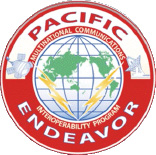Capacity Building with Satellite for Disaster Response: Pacific Endeavor 2020
by Martin Jarrold
London, UK, June 1, 2020--I opened my previous column for this publication one month ago with the following statement: “In starting to draft this column it was impossible not to be affected by the news that the official global figure for Covid-19 fatalities was approaching 200,000. The zoonotic – interspecies – jump to humans and subsequent pandemic spread of the novel coronavirus (SARS-CoV-2) has badly impacted many of the world’s most advanced and richest countries, but the epidemiology tells us that the worst of the impact, on the less-developed world, is still to come.”
The worst of the impact of Coronavirus on the developing world is still, “still to come”, and it will very likely be catastrophic. The impact of pandemic globally has now exceeded 360,000 fatalities, and the death toll in the world’s richest nation has been a disaster, with more than 104,000 fatalities at time of writing.
This is a humanitarian crisis, but not one that can be characterized by familiar notions of events needing disaster response. However, there have been commonalities, including the requirement for rapidly and much enhanced broadband connectivity infrastructure to meet the demands of extended medical services for diagnosis of infection and treatment of disease, and to support the new social isolation/working from home paradigm.
Natural disasters around the world take many forms: earthquakes, tsunamis, cyclones/hurricanes/typhoons, volcanic eruptions, floods, droughts, and famine. These, and such human-made disasters as war, and displaced and refugee populations, are the events which usually grab the headlines. It is these events which require the kinds of solutions for immediate response logistics operations and longer-term recovery programs that only satellite can provide. This is particularly the case when terrestrial communications infrastructures are knocked-out by the nature and magnitude of a disaster itself, and just at the time when they are needed most.
Of course, whilst Covid-19 continues its current grasp of the front pages (and their social media equivalents), other disasters do not stop. Currently, a “plague” of locusts is consuming its way across eastern Africa, the Arabia peninsula, and south Asia; and, Super-Cyclone Amphan has wreaked havoc in Bangladesh and north-eastern India. The recurrence of these disasters only serves to exacerbate both the instance and effects of pandemic as, again as I wrote last month, “…infection takes hold in lower-income countries, affecting communities with weak health systems, affected by conflict, comprising displaced peoples, or which are permanent high-density slums,…”.
The third, and final, citation of my previous column here is to reiterate that GVF is the only globally-based representative body for the satellite industry that is – along with a number of its member companies – signatory to the UN Crisis Connectivity Charter, and is the only private sector representative entity in the World Food Program administered Emergency Telecommunications Cluster.
 This pedigree is further augmented by GVF’s long-standing collaborative partnership with the annual Pacific Endeavor program, the next of which – pandemic circumstances permitting the current schedule arrangements to proceed – will take place in early August this year.
This pedigree is further augmented by GVF’s long-standing collaborative partnership with the annual Pacific Endeavor program, the next of which – pandemic circumstances permitting the current schedule arrangements to proceed – will take place in early August this year.
Since 2012 GVF has engaged with the U.S. Department of Defense Indo-Pacific Command (US-INDOPACOM, formerly PACOM) Multinational Communication Interoperability Program (MCIP) for Humanitarian Assistance & Disaster Response (HADR) – Pacific Endeavor. Over the years we have variously conducted presentation sessions, and hands-on practical training workshops to certify J6 military officials of participating nations in the installation and maintenance of satellite terminals to ensure that during crisis or disaster GVF-certified first responders are on the ground, across the Indo-Asia-Pacific region.
In 2020, the primary element of the Pacific Endeavor mission to bring communications capacity building to the militaries of over 25 nations and their civilian partners – to advance reliable and interoperable communications and cyber operations – will be Satcom Endeavor. At the request of MCIP, GVF has been tasked to coordinate capacity building initiatives for Satcom Endeavor 2020 over the two-week period 3-14 August. Military communications and signals personnel, United Nations agencies, the international humanitarian community, academia, as well as industry, will gather in San Diego, California, U.S.A., for this important high-visibility event.
I first had the opportunity to personally contribute to a Pacific Endeavor program in August 2019, when I had the experience and privilege of visiting Port Moresby in Papua New Guinea. Together with my GVF colleague, Riaz Lamak, GVF’s Pacific Endeavor Lead who acts as point of contact with MCIP, I had the pleasure of working with the MCIP team (which is based out of Camp H. M. Smith in Hawaii), and met the senior officers of many Indo-Pacific militaries.
In San Diego, satellite industry organizations, GVF Members and others, will have the opportunity to showcase new solution innovations, equipment and systems, case studies, and best practices. In supporting Satcom Endeavor companies will benefit from having their product and service solutions seen in action by militaries and disaster preparedness agencies, through: Participant practical hands-on experience in on-site “live” set-up of equipment; Static displays during a “Tech Demo Day”; Speaking slot(s) for technical presentations on new technologies and solutions; Mentored online classroom training modules with one-to-one and group interaction; Face-to-face networking opportunities with military signals officers responsible for solutions specification, evaluation, and final procurement; Products/solution promotion through GVF press and social media; Distribution of product/service collateral; Coverage by the military media; Exposure via de-classified press releases by U.S. DoD and coverage of systems and solutions through internal DoD communications; and, Coordination with U.N. agencies, academia, and NGOs.
As we all focus on the current pandemic – and look forward to a global mass vaccination program when the virologists and pharmacologists triumph over the Coronavirus – it is important not to lose sight of other disasters, those arising from the forces of nature and from the mistakes of human action. For more information Riaz Lamak can be contacted at riaz.lamak@gvf.org
 Martin Jarrold is Vice-President of International Program Development of GVF. He can be reached at: martin.jarold@gvf.org
Martin Jarrold is Vice-President of International Program Development of GVF. He can be reached at: martin.jarold@gvf.org






